Econometrics Final Exam Review PDF

| Title | Econometrics Final Exam Review |
|---|---|
| Course | Introduction to Econometrics FW |
| Institution | University of Guelph |
| Pages | 11 |
| File Size | 375.1 KB |
| File Type | |
| Total Downloads | 110 |
| Total Views | 148 |
Summary
numerical questions and multiple choice questions with answers...
Description
Econometrics Final Exam Review: MULTIPLE CHOICE QUESTIONS: Which of the following terms measures the association between two variables? A: Correlation In the equation
, what is the estimated value of
?
A: Consider the following regression model: y = 0 + 1x1 + u. Which of the following is a property of Ordinary Least Square (OLS) estimates of this model and their associated statistics? A: The point (
) always lies on the OLS regression line.
A data set that consists of a sample of individuals, households, firms, cities, states, countries, or a variety of other units, taken at a given point in time, is called a(n) _____. A: cross-sectional data set If xi and yi are positively correlated in the sample then the estimated slope is _____. A: greater than zero Which of the following refers to panel data? A: Data on the birth rate, death rate and population growth rate in developing countries over a 10-year period. If a change in variable x causes a change in variable y, variable x is called the _____. A: explanatory variable What does the equation
denote if the regression equation
is ? A: The sample regression function The term u in an econometric model is usually referred to as the _____. A: error term The coefficients of an econometric model _____. A: describe how the variable under study responds to changes in the factors affecting it Which of the following is an example of time series data? A: Data on the gross domestic product of one country over a period of 45 years.
Which of the following refers to panel data? A: Data on the birth rate, death rate and population in Canadian provinces over a 15-year period. Which of the following is true? A: The notion of ‘ceteris paribus’ plays an important role in causal analysis. A response variable is also known as a(n) _____. A: dependent variable If a change in variable x causes a change in variable y, variable x is called the _____. A: explanatory variable
What does the equation
denote if the regression equation
is ? A: The sample regression function Which of the following is a nonlinear regression model? A: y = 1 / (
0
+
1
x) + u
Consider a simple linear regression model, wage = + male + u , where male is a binary variable (1 if a person is male, and 0 otherwise). Now suppose that we know being a male means there is a higher probability of long job market tenure, another factor that is also expected to affect wage. Which of the key assumptions made to establish unbiasedness of OLS estimates do not hold? A: Zero conditional mean Consider the following regression model: y = 0 + 1x1 + u. Which of the following is a property of Ordinary Least Square (OLS) estimates of this model and their associated statistics? A: The point (
) always lies on the OLS regression line.
If xi and yi are positively correlated in the sample then the estimated slope is _____. A: greater than zero Consider the variance of the slope estimator. As the error variance decreases, the variance of βˆ1 A: decreases
Consider a simple linear regression model, y = β 0+ β 1x + u , . What does the zero conditional mean assumption imply? A: The expected value of the error term, u , is zero, regardless of what the value of the explanatory variable, x, is.
What does the equation
denote if the regression equation
is ? A: The sample regression function Suppose the relationship between wage, years of education (educ), years of experience (exper), and participation in a job training program (train) is modeled as: log ( =
+
+
+
interpretation of the coefficient,
)
. Which of the following is the most accurate ?
A: Holding education and experience constant, participating in the training program is predicted to increase the wage by Suppose the variable
has been omitted from the following regression
equation, omitted from the equation. If A: have an upward bias
is the estimator obtained when
is
is said to _____.
High (but not perfect) correlation between two or more independent variables is called _____. A: multicollinearity Which of the following is true of BLUE? A: It is the best linear unbiased estimator. Which of the following is true of R2? A: R2 shows what percentage of the total variation in the dependent variable, Y, is explained by the explanatory variables.
Consider the equation, y = + 1x1 + 2x2 + u. A null hypothesis, H0: A: x2 has no effect on the expected value of y.
2
= 0 states that:
The significance level of a test is: A: the probability of rejecting the null hypothesis when it is true. The general t statistic can be written as:
A: t = Which of the following statements is true? A: The upper bound of the confidence interval for a regression coefficient, say âj, is given by
+ [Critical value × standard error (
)].
Which of the following 95% confidence intervals for the estimate of the population treatment effect is the most convincing evidence that a policy intervention was indeed effective? A: (0.5, 0.75). In the following regression equation, y is a binary variable: y=
+
0
x +…
1 1
k
xk+ u
In this case, the estimated slope coefficient, βˆ1β^1 measures _____. A: the predicted change in the probability of success when x1 increases by one unit, everything else remaining constant Consider the following regression equation: y =
0
+
x + …+
1 1
k
xk + u
In which of the following cases, the dependent variable is binary? A: y indicates whether an adult is a college dropout Which of the following Gauss-Markov assumptions is violated by the linear probability model? A: The assumption of constant variance of the error term.
Consider the model: log (wage) = + female + graduate + female * graduate + u , where graduate is a dummy variable (1 if the person has graduated from college, and 0 otherwise), and female is a dummy variable (1 if the person is female, and 0 otherwise). Which of the following measures the return of graduating from college for men? A:
+
Consider the following regression equation: graduate = + female + score + u where graduate is a dummy variable (1 if the person graduated from college, and 0 otherwise), female is a dummy variable (1 if the person is female, and 0 otherwise), and score is the college admission test score. What does
measure?
A: The predicted difference in probability of graduating between female and male students, all else equal.
NUMERICAL QUESTIONS: If the residual sum of squares (SSR) in a regression analysis is 18 and the total sum of squares (SST) is equal to 50, what is the value of the coefficient of determination? Answer as number, not percent. ROUND TO TWO DECIMAL POINTS. A: 0.64 (1-(18/50)) A simple regression model y=β0+β1x+u is estimated on a sample of size 100. How many degrees of freedom are in the estimator? GIVE THE ANSWER AS AN INTEGER NUMBER (without any decimals). A: 98 (100-1-1) The following regression line yˆ =400 + 8 x has been estimated from a sample of 200 observations. What is the value of the residual uˆI at the point (xi, yi ) = (40, 30) ? GIVE THE ANSWER AS INTEGER; NO DECIMALS; INCLUDE THE MINUS SIGN IF NECESSARY. A: -690 (30-(400+8*40)) Consider the following estimated regression line: wageiˆ=βˆ0+βˆ1malei where wage are wages in dollars, male is a gender indicator equal to zero for females and equal to one for males, and the estimated coefficients are β^0=25 and β^1=5. What is the predicted wage of women (for whom male = 0) in the estimating sample? A: 25 (25+0) Consider the following estimated regression line: lnwageiˆ=βˆ0+βˆ1educi where lnwage is log wage and educ is thenumber of year of education, and the estimated coefficients are βˆ0=6.80 and βˆ1=0.053. One extra year of education increases wages by how many percentage points? REPORT THE ANSWER WITH ONE DECIMAL A: 5.3 (0.053)
Consider the following regression estimation of hourly wages on education, experience and experience squared: wageˆ=15.4+0.85⋅educ+βˆ⋅exper−0.05⋅exper2 where the coefficient on experience is 6. What is the effect on hourly wages of one extra year of experience evaluated at 10 years of experience, all else equal? Enter the answer with one decimal point. A: 5.0 (6*11-0.05*11^2 – (6*10-0.05*10^2)) Regressing Xj on all other X produces an R-squared R 2j = 0.8. What is the variation inflation factor VIF entering in the formula for the variance? Report the answer with one decimal point. A: 5.0 (1/(1-0.8)) To evaluate the returns to university education the following regression model log(wage)ˆ=β0ˆ+β1ˆ⋅university+β2ˆ⋅ability is estimated by researchers in a secure location. The researchers find that the constant is 2.2, the coefficient on the university indicator is 0.27 and the coefficient on ability is 0.17. They run a separate regression abilityˆ=δ0ˆ+δ1ˆ⋅university and they find out that the constant is 0.6 and the coefficient on university in this second regression is 0.4. They try to replicate this analysis on the same sample but with public data which does not contain the ability variable, by running the regression Q ⋅university log(wage)ˆ=βQ0ˆ+β1ˆ What is the magnitude of the bias in the coefficient on university βE1in this final regression? Report the result with 2 decimal points. A: 0.07 (0.17*0.4)
The following log wage regression has been estimated: log(wage)ˆ=β0ˆ+β1ˆ⋅educ+β2ˆ⋅age+β3ˆ⋅sex+β4ˆ⋅unionlog(wage)^=β0^+β1^⋅educ+β2^⋅age+β3^⋅ sex+β4^⋅union with the following estimated coefficients: constant 2.12, coefficient on education 0.78, coefficient on age 0.05, coefficient on sex -0.26 and coefficient on union 0.15. To verify the partialling-out effect of OLS, a separate regression is run with educ as the dependent variable and age, sex and union as the independent variables. The residuals from this regression, reducˆ are then used in a univariate regression with log wages as dependent variable, where the following regression line is estimated: log(wage)ˆ=δ0ˆ+δ1ˆ⋅reducˆlog(wage)^=δ0^+δ1^⋅reduc^ What is the value of δ1ˆ? Report the answer with two decimal points. A: 0.78 (0.78) Consider the following estimation logwageˆ=5.86+β1ˆuniversity+0.05experience(0.87)(0.060)(0.021) where the standard errors are respectively 0.87 (for the constant), 0.060 (for the coefficient on university) and 0.021 (for experience). The sample size used in estimation is N=2,000. The estimated coefficient for university is 0.65. Construct a 90% confidence interval for the university coefficient β1. What is the lower end of this confidence interval? Report your answer with two decimal points. Pay attention to which critical value you choose. A: 0.55 (0.65 – 1.65(T-value ( DF=1997, significance level=0.1)) * 0.06) Consider the following estimation logwageˆ=3.96+β1ˆuniversity+0.03age(0.29)(0.060)(0.018) where the standard errors are respectively 0.29 (for the constant), 0.060 (for the coefficient on university) and 0.018 (for age). The sample size used in estimation is N=1,500. The estimated coefficient for university is 0.50. Construct a 95% confidence interval for the university coefficient β1. What is the upper end of this confidence interval? Report your answer with two decimal points. Pay attention to which critical value you choose. A: 0.62 (0.5 + 1.96 ( T value (DF=1497, significance level=0.05)) * 0.06)
Consider the following estimation logwageˆ=5.86+β1ˆuniversity+0.05experience(0.87)(0.060)(0.021) where the standard errors are respectively 0.87 (for the constant), 0.060 (for the coefficient on university) and 0.021 (for experience). The estimated coefficient for university is 0.55. What is the t-statistic for testing the null hypothesis H0:β1=0? Report your answer with two decimal points. A: 9.17 (0.55/0.06) Consider the following estimation logwageˆ=5.86+β1ˆuniversity+0.05experience(0.87)(0.060)(0.021) where the standard errors are respectively 0.87 (for the constant), 0.060 (for the coefficient on university) and 0.021 (for experience). The estimated coefficient for university is 0.55. What is the t-statistic for testing the null hypothesis H0:β1=a where a =0.35? Report your answer with two decimal points. A: 3.33 ((0.55-0.35)/0.06) Consider the following estimation logwageˆ=5.86+β1ˆuniversity+0.05experience(0.87)(0.060)(0.021) where the standard errors are respectively 0.87 (for the constant), 0.060 (for the coefficient on university) and 0.021 (for experience). Given the estimated coefficient for university (not reported here), the p-value from testing the hypothesis H0:β1=0 against the alternative HA:β1≠0 is p=0.054. In this estimation, what would be the p-value in a one-sided hypothesis test of the same null against the alternative HA:β1>0? Report your answer with three decimal points. A: 0.027 (0.054/2)
A group of workers get selected either into participating in training (D=1) or not participating in training (D=0). Six months after training the following wage equation is estimated, separately for each training group D=0 and D=1: log(wage)=β0+β1exper+β2educ+β3sex+β4married+u where exper is months of labour market experience, educ is years of education, sexis a gender indicator (0=male; 1=female) and married is a marital status indicator (0=single 1=married). Instead of separate regressions for each of the groups, we can run one equivalent fully interacted model on the entire sample, where D, D*exper, D*educ, D*sex and D*married are all added as regressors. If sample size is 4850, how many degrees of freedom are there in the unrestricted (fully interacted) model? Report the answer as integer (no decimals). A: 4840 (4850-5-5) A group of workers get selected either into participating in training (D=1) or not participating in training (D=0). Six months after training the following fully interacted unrestricted model is estimated: log(wage)=β0+δ0D+β1exper+δ1D∗exper+β2educ+δ2D∗educ+β3sex+δ3D∗sex+β4married+δ4 D∗married+u where exper is years of labour market experience, educ is years of education, sex is a gender indicator (0=male; 1=female) and married is a marital status indicator (0=single 1=married). The estimated model is log(wage)ˆ=2.510+0.057D+βˆ1exper+δˆ1D⋅exper+0.392educ+0.031D⋅educ−0.183sex+0.072D⋅s ex+0.021married+0.0004D⋅married The coefficient on exper is 0.035 and the coefficient on D*exper is 0.007. What is the marginal effect of one extra year of experience on wages (in percent)for the control group D = 0 ? Report the result with one decimal point. A: 3.5 (0.035)
A group of workers get selected either into participating in training (D=1) or not participating in training (D=0). Six months after training the following fully interacted unrestricted model is estimated: log(wage)=β0+δ0D+β1exper+δ1D∗exper+β2educ+δ2D∗educ+β3sex+δ3D∗sex+β4married+δ4 D∗married+u where exper is years of labour market experience, educ is years of education, sex is a gender indicator (0=male; 1=female) and married is a marital status indicator (0=single 1=married). The estimated model is log(wage)ˆ=2.510+0.057D+βˆ1exper+δˆ1D⋅exper+0.392educ+0.031D⋅educ−0.183sex+0.072D⋅s ex+0.021married+0.0004D⋅married The coefficient on exper is 0.030 and the coefficient on D*exper is 0.006. What is the marginal effect of one extra year of experience on wages (in percent)for the treatment group D = 1 ? Report the result with one decimal point. A: 3.6 (0.03+0.006) A group of workers get selected either into participating in training (D=1) or not participating in training (D=0). Six months after training the following fully interacted unrestricted model is estimated: log(wage)=β0+δ0D+β1exper+δ1D∗exper+β2educ+δ2D∗educ+β3sex+δ3D∗sex+β4married+δ4 D∗married+u where exper is years of labour market experience, educ is years of education, sex is a gender indicator (0=male; 1=female) and married is a marital status indicator (0=single 1=married). The sum of squared residuals in the fully interacted model is SSRu = 43.0. To test the hypothesis that there is no treatment effect H0:δ0=δ1=δ2=δ3=δ4=0, a restricted model is estimated on the same sample: log(wage)=β0+β1exper+β2educ+β3sex+β4married+u The sum of squared residuals in the restricted model is SSRr = 87.0. The sample size is 700. What is the F statistic for the null hypothesis above? Round the result to one decimal point. A: 141.2 (((87 - 43) / 5) / (43 / (700 - 10))) An OLS equation is estimated on a sample size 400 with 3 regressors (not including the constant). The resulting sum of squared residuals is 55 and the total sum of squares is 71. What is the adjusted R-squared R¯2? Report the result with two decimal points. A: 0.23 (1- (55/396)/(71/399))...
Similar Free PDFs

Econometrics Final Exam Review
- 11 Pages

Econometrics - Final Exam
- 4 Pages

Chem Final Exam Review
- 12 Pages

Final Exam - Review notes
- 92 Pages

Bio Final Exam Review
- 2 Pages

Final EXAM Review booklet
- 5 Pages
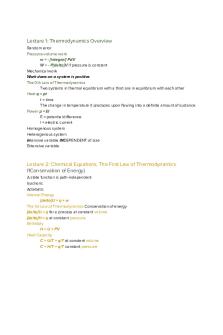
CHEM303 final exam review
- 4 Pages

Psychology Final Exam - Review
- 13 Pages
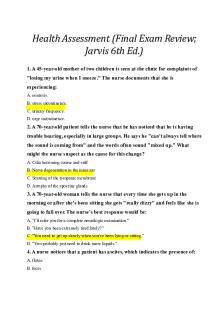
Jarvis Final Exam Review
- 12 Pages
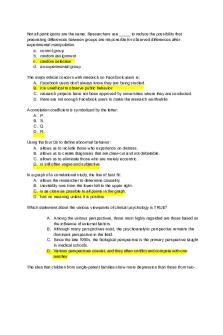
Final exam review
- 96 Pages
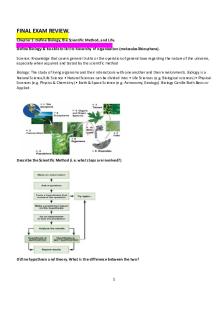
Final Exam Review
- 48 Pages
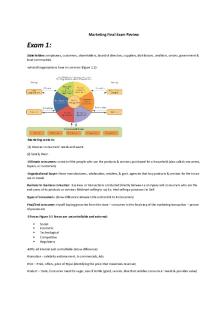
Marketing Final Exam Review
- 15 Pages
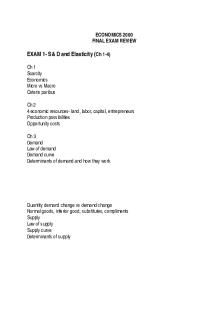
Final exam review
- 8 Pages
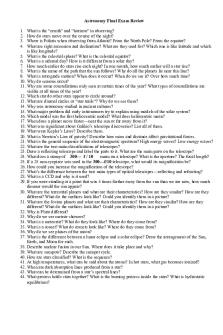
Astronomy Final Exam Review
- 2 Pages
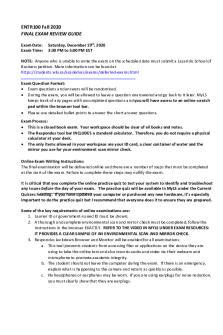
Final Exam Review Guide
- 4 Pages
Popular Institutions
- Tinajero National High School - Annex
- Politeknik Caltex Riau
- Yokohama City University
- SGT University
- University of Al-Qadisiyah
- Divine Word College of Vigan
- Techniek College Rotterdam
- Universidade de Santiago
- Universiti Teknologi MARA Cawangan Johor Kampus Pasir Gudang
- Poltekkes Kemenkes Yogyakarta
- Baguio City National High School
- Colegio san marcos
- preparatoria uno
- Centro de Bachillerato Tecnológico Industrial y de Servicios No. 107
- Dalian Maritime University
- Quang Trung Secondary School
- Colegio Tecnológico en Informática
- Corporación Regional de Educación Superior
- Grupo CEDVA
- Dar Al Uloom University
- Centro de Estudios Preuniversitarios de la Universidad Nacional de Ingeniería
- 上智大学
- Aakash International School, Nuna Majara
- San Felipe Neri Catholic School
- Kang Chiao International School - New Taipei City
- Misamis Occidental National High School
- Institución Educativa Escuela Normal Juan Ladrilleros
- Kolehiyo ng Pantukan
- Batanes State College
- Instituto Continental
- Sekolah Menengah Kejuruan Kesehatan Kaltara (Tarakan)
- Colegio de La Inmaculada Concepcion - Cebu
